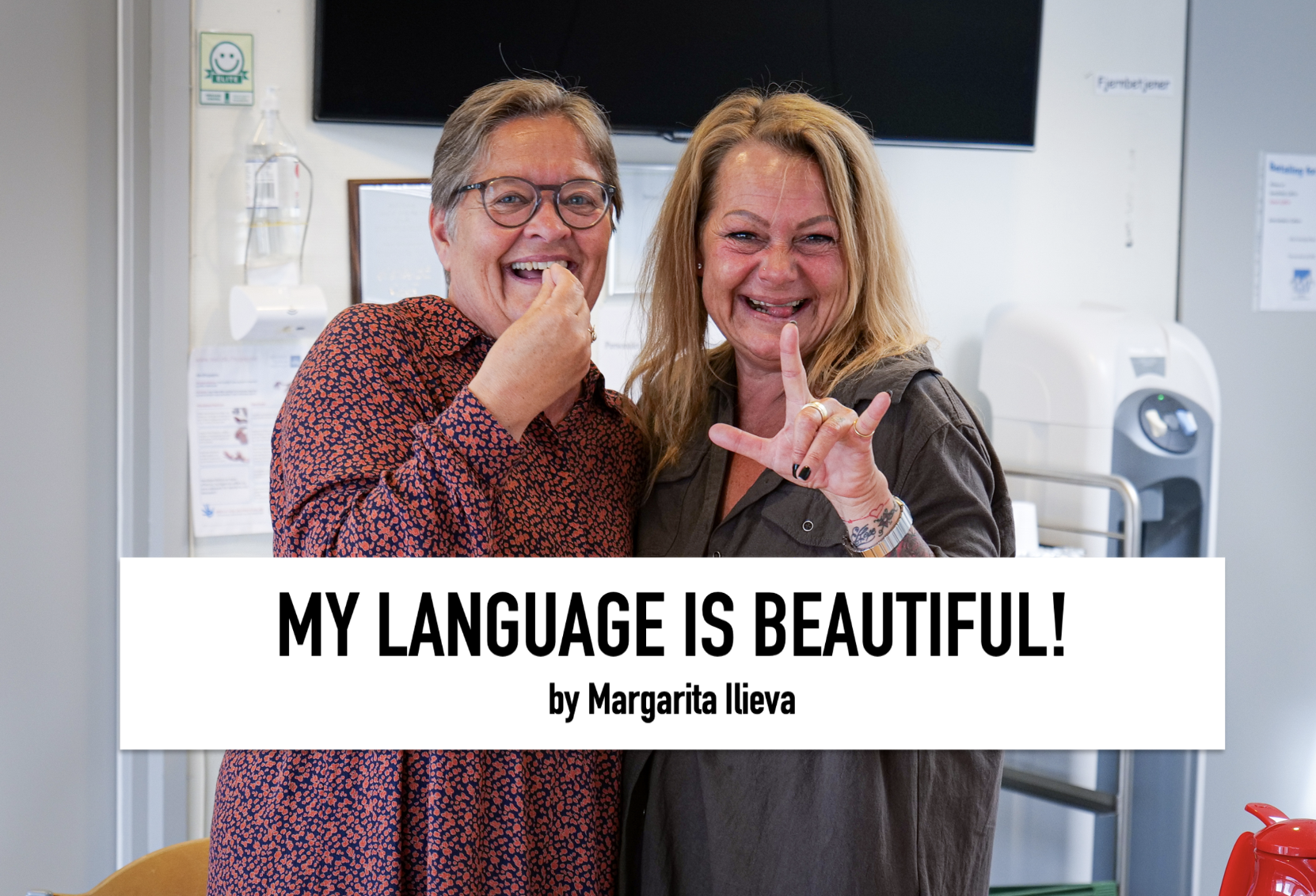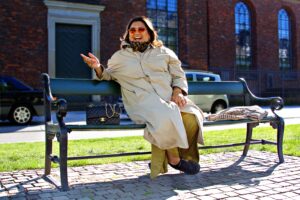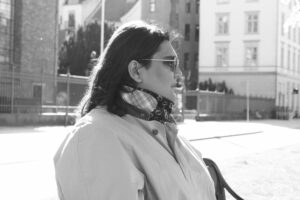People with hearing loss are often not those we think of first when speaking about disabilities. Their condition is invisible, and they are accustomed to dealing with a variety of daily obstacles. For many deaf people, the pandemic wasn’t just another challenging situation, which they had to master. It also had a major benefit for the whole community using sign language in Denmark: It made it visible.
BY MARGARITA ILIEVA | JUNE 2021
Around 20,000 persons in Denmark use Danish sign language, with roughly 4.000 of them being deaf. For a country with 5,8 million inhabitants, this means only 0,068 per cent of the population or 1 in 1450 are deaf (Source: Danish Deaf Association or DDL). It could be seen as a small number, which would explain why the people with hearing loss might not always be those we tend to think about first when speaking about disabilities.
However, when the COVID-19 pandemic reached Denmark in March 2020, suddenly the Danish sign language gained popularity because of the interpreters, who were standing next to prime minister Mette Frederiksen and her colleagues during the press conferences, interpreting in sign language.

However – in the beginning, the press conferences were not translated into sign language, which has been seen as proof that the authorities weren’t aware of the deaf and hard-of-hearing community also needing to get access to the information. This was when DDL stepped in and made the government aware of the issue.
Brit Holm Andresen, who is a consultant at the DDL and has experienced hearing loss herself, says that it was a long process to convince the authorities of the need for a sign language interpretation:
“We were having a lot of dialogues with the ministers, different ministers. And then we agreed on yes, there could be an interpreter,” she shares. In her opinion, the pandemic was a clear showcase for the gap between Denmark and other countries when it comes to ensuring deaf people’s access to information.
“We could then point at other countries that were ahead of us like the United States and several other countries that always have an interpreter when there are press meetings, and say – look, we need the same here,” adds Andreasen.

DDL is the main institution for the deaf in Denmark and its mission is to make the Danish sign language more visible and increase access to information.
The face mask as a major barrier for the hard-of-hearing
For some people social distance, regular testing and face masks have been a major intervention in their everyday life since the beginning of the pandemic. But for a person with hearing loss, the face mask is not just preventing the spread of the infection. It has become a barrier hindering them from participating fully in the communication. Yet, because deaf people still utilize sign language, the face mask might be less of an obstacle for them than for hard-of-hearing individuals.
One of them is Merete Birk Nielsen, who describes herself as ‘’belonging to three worlds: the deaf, the hard-of-hearing and the hearing world”. She has acquired the ability to speak, which often leads to misunderstandings in her surroundings when it comes to communicating with a face mask on:
“People forget all the time and don’t realize that I do not hear without lip-reading. So they keep talking and I get more and more irritated,” she says.
The major problem in cases like hers is the missing social interactions in everything from a trip to the supermarket to doctor’s appointments: “The interaction and the small talk every day in the supermarket, when you’re living in a little community that knows each other, is lost,” she says sadly.
Apart from the misunderstandings in real-life communication, when it comes to adapting to online communication in the working environment, the increased screen time and long-term concentration are taking their toll on one’s physical condition. Especially for those relying on sign language, it can be exhausting to conduct the work in the new conditions:
“Everybody found out that long meetings on the computer online tire people, and I think hard of hearing even more. Their brain has to work hard to figure out what are they saying, what’s going on, who’s talking now,” Merete shares her experience.

Her job as project leader at the community college Castberggård, where she supports people with hearing loss in their job, requires long screen time sessions. She shares that many are not even aware of the technical gear that’s needed to be able to fully participate in digital work: “They didn’t know how to do it and where to go to ask for it, to be guided in the system and how to get it in.”
The lack of access to information for the different opportunities hard-of-hearing people have is also criticized by DDL:
“There are hard-of-hearing people, who are not aware that they have the right to have an interpreter and they don’t know about the different opportunities for interpreting,” points out as well Brit Holm Andreasen.
How the pandemic changed the Danish sign language
In the pandemic, the Danish sign language had to adapt to the communication through the screen during online meetings. This resulted in the formation of new signs for things that were difficult to translate literally, such as “contact person” or “hoarding.” Niemelä reports that the research in the US and Norway has shown that there have been changes in American Sign Language and Norwegian Sign Language, so that she and her colleagues assume that this also applies to Danish Sign Language.
“We have now a lot of new signs that came into the language, but another thing that is indirectly an effect from corona has been that we talk online much more than we did before. And that has actually changed the sign language already, a little bit, we can see,” explains Janne Boye Niemelä, who works as a researcher at the department for Danish sign language at the Danish language council.

Another major difference in the language was its adaption to the two-dimensional screen, making it harder to comprehend certain signs that might look alike and additionally increasing the exhaustion after a few hours of online meetings.
Sign language interpreters becoming a trend
With the raised awareness towards the people with a hearing loss that resulted from the pandemic, also those providing the information were more and more often in the spotlight – the sign language interpreters.
Melissa Sophia Kristensen is a student in sign language interpreting at the Copenhagen professional school. She experienced the increased interest in her future job in the past 1,5 years: “People more and more understand what sign language interpreting actually is and that we exist, because we’re now very visible on screen especially during the press conferences,”, she says.
What seems to be a huge milestone for the deaf community, Melissa sees as a source of criticism, since Denmark is beginning to do something that has long been standard in many other countries:
“I think it’s really sad that it took a pandemic to make it very visible – both interpretation as a job and a job option, but also the deaf people and their culture, language and world,” points out Melissa.
The increased attention to the job of sign language interpreters however has also its problematic downsides. For sign language interpreter Emilie Ingeborg Lykfeldt the interest towards her job oftentimes predominates over the acknowledging of its purpose – to facilitate the communication for a deaf person:
“It’s an incredibly positive thing that my profession has gotten some attention now that people have a concept of what I do. But there’s something quite problematic about it – the focus stops at me, the hearing person, who happened to know sign language, but they don’t take it further and say ‘oh, she’s there because there’s a deaf person who’s in need of sign language interpretation in order to be included in society’”, explains Lykfeldt her concerns on the tendency she observes.

For her, it’s essential to draw attention to the fact that there is a deaf community in Denmark that relies on sign language interpreters. Even if the increased interest she experiences is per se a milestone for the visibility of the deaf community, to her “it’s still a shame because it means that there’s no inclusion, the deaf person is still outside. I could have wished for more attention towards the big WHY behind the interpreter – why are there interpreters and why is it important.”
Biggest challenge: A lack of information
The lack of information or merely its slow distribution to the deaf people is what’s mainly seen as missing in the conversation about the inclusion of the people with hearing loss.
Signe Amalie Stubbe lost her hearing when she was 11 months old. As a part of the non-hearing community for her the main lesson the Danish authorities can learn from the pandemic is that “it should give some clear information as quickly as they give it to everyone else. So you don’t have to ask your colleagues and everyone around ‘what is happening?’ – you just know it as soon as everyone else,” says Signe.
What seems to be an urgent solution now leaves the question open what the perspective for the deaf community in Denmark on the long run is – will the new standards be upheld once the pandemic is over or will the Danish sign language follow the famous saying “Out of sight, out of mind?”
Asked about her vision on the sign language’s future, Signe shares her belief that medical progress and advancements in cochlear implant technology will mean the end of sign language in the future:
“My language is so beautiful, so I will be very sad if it won’t survive. But I can see that happening because the group is getting smaller and smaller and at the moment we are only about 4.000 here in Denmark”, she says sadly.
Signe encourages people to learn and know about her language, as she tries to use her voice as much as she can to support the communication: “So, everyone can learn it – I try to use my voice in communication, so hearing people can also try to use their hands!“


